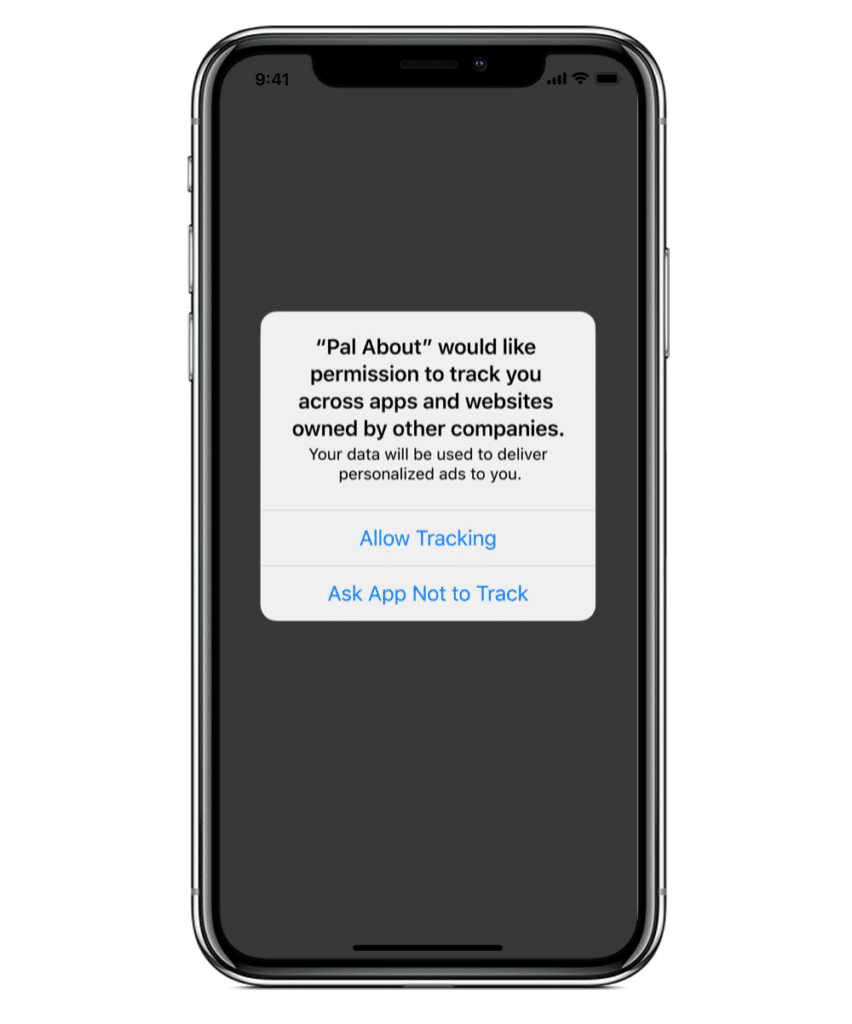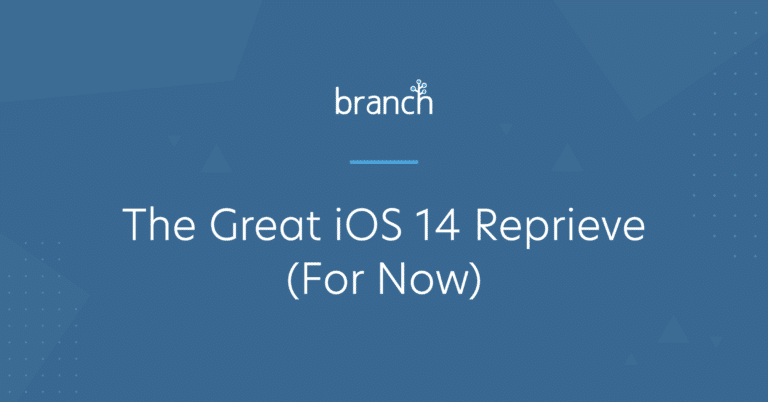Note: As of January 28th, 2021, Apple has changed its policies regarding attribution on iOS 14. Information in this blog post may no longer apply. Read about that update and Branch’s latest stance here.
Chalk one up for the rumor mill – IDFA deprecation is officially on ice for the next few months.
Apple confirmed this morning that, “to give developers time to make necessary changes” they would postpone required adoption of the IDFA opt-in module until early next year.
As a voice of many of the largest advertisers in mobile, we’re pleased that Apple listened to Branch, alongside many others in the space, and made the responsible decision to delay the most disruptive change in iOS 14 until 2021.
Giving the mobile community enough time to embrace an IDFA-less world in a way that takes into consideration both developers’ needs and user experience is a welcome update — but this is no time to get comfortable.
The 30-Second Summary
- This isn’t a fundamental policy reversal, just a slight delay in functional IDFA deprecation
- You should still prioritize updating your Branch integration, as recommended over the past few weeks, so you can start comparing device-level and SKAN data in parallel.
- Don’t implement the AppTrackingTransparency modal yet — if you’re looking to experiment, use a soft prompt for now
- Enjoy the long weekend (if you’re in the US!), but don’t put your strategy discussions on hold for long
What This Change Means Functionally
The IDFA
Make no mistake, the IDFA is functionally still going the way of the dodo next year. In the meantime, however, it will continue to be available without explicit user opt-in.
In contrast to previous iOS 14 Beta versions, Beta 7 (released this morning) returns IDFAs without users opting-in via the previously required module.

Before Apple’s timing update, most companies indicated they would forego IDFA altogether, rather than show this opt-in popup. Unless you’re fully committed to pursuing IDFA opt-in long-term, here’s our advice: don’t waste your time experimenting with the actual module over the next few months.
Why? Well, our team is continuing to test the latest beta, but here’s a breakdown of the behavior we’re seeing so far:
- For now, if you don’t ask, you keep getting the IDFA (this is the meat of Apple’s timing update today).
- If you ask and the user opts-in, you’ll get the IDFA both now and after Apple starts enforcing.
- If you ask now and the users opts-out, you won’t get the IDFA both now and after Apple starts enforcing next year.
- If the device-wide “Allow Apps to Request To Track” setting in iOS 14 is off, you don’t get the IDFA — both now, and after Apple starts enforcing. This is functionally the same as LAT today, except the direction of the toggle is reversed.
Ad Networks
Since WWDC 2020, most of our Ad Network partners have indicated a desire to build support for both SKAdNetwork and Predictive Modeling. However, having both methods available in time for iOS 14 was a major challenge, especially given the difficulties so far in testing the current SKAdNetwork 2.0 betas.
Thanks to the delay in IDFA deprecation, we expect that most Ad Networks will continue to provide attribution through their existing IDFA-contingent methodologies, but will also prioritize building for the future where SKAN and Predictive Modeling operate in parallel.
Our partnerships team is already in active communication with SANs and non-SANs alike and we’ll provide updates in real-time through our Customer Success and Support teams and our iOS 14 Resource Hub.
SKAdNetwork Support
Branch support for SKAdNetwork is available through our current SDK releases to enable side-by-side views of SKAN and non-SKAN attribution methodology results.
As we’ll discuss below, the next few months are critical in terms of User Acquisition teams building a scalable SKAN strategy and learning to use non-IDFA device-level data and aggregate data side-by-side.
What Should Branch Clients Do Over the Next Few Months?
This is the million-dollar question (or more, depending on your monthly performance budget!)
To make the most out of the iOS 14 reprieve, we’re encouraging our clients to focus on four key areas:
-
- SKAdNetwork Ad Strategy Creation
- Network and Ad Format Review
- Full Funnel Focus
- Monetization Strategy Review
SKAdNetwork Ad Strategy Creation
SKAdNetwork provides far fewer data points for advertising optimization than advertisers are used to seeing today. There are only two fields that an advertiser can leverage to understand everything from creative, content, and geolocation efficacy to overall ad impact on downstream conversions – Conversion Values and Campaign IDs.
Conversion Values are the means by which SKAN gives advertisers insight into post-install success events (ex: Commerce Events, Lifecycle Events, Content Events, Custom Events). Today, these Custom Events are typically tracked through an MMP and posted back to the relevant ad network as they occur.
In the SKAdNetwork paradigm, advertisers get 64 possible Conversion Values, designated by the numbers 0-63 with only one postback per install. That means companies only have 64 values to capture the full scope of an ad’s impact on in-app behavior – oh, and it’s on a timer so if your user doesn’t do anything within 24 hours, adios any additional information.
Allocating Conversion Values appropriately and balancing the need to get install information back quickly vs. pushing out data receipt by 24 hours at a time to get further success metrics will be a key part of fleshing out and testing your Conversion Value strategy.
Campaign IDs are the means by which SKAN gives advertisers insight into the ad sets, creatives, content, etc. that drive installs and conversions. Today these are all separate parameters, defined by the ad network itself, by which campaigns can be split and optimized.
In the SKAdNetwork paradigm, advertisers get 100 possible Campaign IDs per network where each integer indicates the only information the advertiser will know about the campaign itself – from location to creative to audience type, significantly limiting the level of campaign optimization granularity.
Allocating Campaign IDs well, creating clear testing plans across networks, and defining clear testing plans for creatives that generate enough postbacks to hit the privacy threshold will be a key part of a successful Campaign ID strategy.
Network and Ad Format Review
In a world in which the same parameter (IDFA) is not available on both ad click and app install, there is a diminished advantage in the value of in-app inventory over mobile web ad inventory. Some of our Agency partners are encouraging their clients to look into relatively inexpensive mobile web inventory to bring down overall CPIs and expand available inventory. Clients should consider where mobile web inventory could supplement social channels and align with specific content or user types.
In addition, many Networks will support both SKAN and non-SKAN ad formats. For clients that strongly favor device-level data, consider exploring which ad types support Branch’s privacy-compliant Predictive Modeling rather than, or in addition to, SKAN attribution.
Lastly, consider bringing the teams responsible for affiliate, partner, and influencer marketing into the discussion.
Full Funnel Focus
IDFA deprecation nullifies some of the top-of-funnel growth strategies where many companies have traditionally focused their performance budget. Leading up to the post-IDFA world, consider further uniting your user acquisition and lifecycle marketing teams’ efforts.
Clean onboarding, quick time-to-value from the app, and a focus on blended CPAs will help ensure that, heading into 2021, your performance budget goes as far as possible by patching the leaky funnel of user churn. Consider how you can quickly reinforce not only your brand value, but how users should think about the app itself, post-acquisition, by leveraging owned channels.
Getting your users back to specific content in the app ASAP by deep linking from your onboarding email or push notifications will help reinforce why the app deserves space on their phone and give you the best shot at ensuring a conversion within a SKAN or Predictive Modeling timeframe.
App Monetization Strategy Review
If your app monetizes through in-app advertising today, evaluate how you can make the most of your inventory in a world without IDFA-based attribution, audience creation, and re-targeting. Some key things to consider may include:
- Working to build content-based ad personalization, either natively or with your partner networks
- Expanding the ad networks/ SSPs that you work with and enabling SKAN and Predictive Modeling support for their ad formats
- Creating or enhancing support for a subscription or in-app purchase model that operates alongside your advertising business.
- One additional item to consider here – as you build revenue projections, be sure to include the Apple App Store 30% commission in your models.
What Will Branch Do With This Time?
Product Initiatives
Our product team is doubling down on our support for iOS 14, moving features initially intended for quick-follow into pre-IDFA deprecation releases. We’ll continue to build new, innovative functionality that supports a tandem world of both SKAN attribution and Predictive Modeling.
Expect to see updates from our team around:
- Conversion Value mapping and optimization
- Fraud detection
- Advanced reporting to uncover new campaign insights, based on the combined SKAN and Predictive Modeling datasets
In addition, we want to hear from you! Without a mad dash to mid-September, we’ll be in touch to solicit feedback on our roadmap, beta launches, and ideas you have for the new world.
Customer Success Partnership
Tactically, our global Customer Success teams are scoping out strategies in line with our clients’ individual advertising strategies, iOS to Android ratios, operating verticals, current product usage, and 12-18 month monetization goals.
We’ll stay in close communication with your product, data, engineering, and marketing teams to:
- Help ideate and execute on the strategies outlined earlier
- Help you source, test and evaluate new ad networks and formats
- Provide our expertise in full-funnel cross-platform attribution and ensure your marketing spend is going as far as possible
- Train your teams on updates to our UI, features and functionality and data exports
Strategically, our goal is to make the ongoing transition as easy as possible for your team and help you translate the complex technical changes in the ecosystem into a strategy that your executive team can lean into and you can execute with confidence.






















